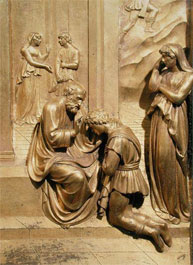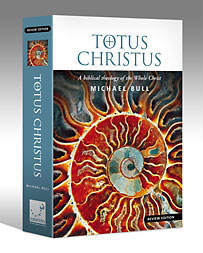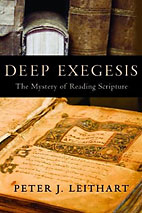Nov
28
2009

or Drive-By Typology
——————————————————————————-
Rome has this whole nutty Oedipus thing going. They want the infantile security of Mary’s breast when God calls them to grow up, to be as individuals men worthy of a bride’s affections, and corporately a bride who adores only her Husband!
——————————————————————————-
Verifying typological connections is a tricky business. Like driving, it is not a skill but an art. This means that although there are certain rules to follow, above all of that there are situations where being steeped in the types and structures of the Bible is the only way to proceed with wisdom. James Jordan recently commented that any such exegesis should be carried out within the conversation of the church, and:
“The popular notion that everyone should be able to read and exegete the Bible equally, as a result of learning some so-called “science” of hermeneutics, is about as stupid as thinking everyone can write music like Bach and Beethoven by studying the rules of harmony and counterpoint; or that anyone can be a Shakespeare.”
I’m no Shakespeare, but James Jordan’s identification of the biblical “universals” and an explanation of biblical types has helped me enormously. The Bible matrix structure has also helped me enormously. They are typological “systematics.” It is this kind of grounding, like practising scales on a piano, that enables us to more easily identify abuses of typology — such as the claim that Mary is a “New Eve.” Dischordant notes can be used to great effect in great music, but it takes a practised musician to know when it is within a greater “harmony” and when it is not. This is beyond the basic scales.
Continue reading
5 comments | tags: Athaliah, Baptism, Bible Matrix, Hermeneutics, James Jordan, Mary, Peter Leithart, Roman Catholicism, Systematic typology, Totus Christus | posted in Biblical Theology
Nov
27
2009

or New Covenant Stunt Double
Doug Wilson wrote something recently to correct our misunderstanding of Jesus’ temptation in the wilderness:
When our Lord was tempted by the devil in the wilderness, He answered with Scripture, as we all know. Three times He was tested, and each time He replied in the words of Deuteronomy. But this is sometimes misunderstood. We tend to think that Jesus was quoting Scripture at the devil, as though the devil ought to start obeying it. But this was not His intent. When the Lord cited the words of Moses, each time it was because He would have been disobeying the text of Scripture if He had followed the suggestion of the tempter.
Continue reading
Comments Off | tags: Achan, Joshua, Nazirite, Peter Leithart, Tabernacle, Table of Showbread | posted in Biblical Theology, The Restoration Era
Nov
19
2009
With Biblical Horizons, nothing is sacred. Or everything is.
Peter Leithart, Creation: Purity
Athanasius’ letter to Amun (354) is a meditation on purity. Defilement, he argues, occurs “when we commit sin, that foulest of things.”That is what Jesus meant when He said that we are defiled by what comes out – out of the heart.
Continue reading
1 comment | tags: Peter Leithart | posted in Biblical Theology, Quotes
Nov
9
2009
or The Modern Absence of Quest

A review of the movie of Maurice Sendak’s classic children’s book observed that the absence of a quest, something to be overcome or achieved, makes the film bland. It has everything else: family issues, fantastic characters and first-rate special effects. But at the end of the day, without a “holy quest” all that is left is a lot of bumming around discovering how cool the world is. Or, worse, like much modern infants’ education, how cool we are.
Continue reading
1 comment | tags: Culture, Film, Peter Leithart | posted in Christian Life
Nov
7
2009

All the names and the numbers in Revelation are symbols based on historical facts. The names are easy. Jezebel, Antipas, Balaam… But we mathematical moderns have trouble taking numbers as symbols. We are only interested in descriptions, not relationships. In the Bible, symbols describe relationships. As David Chilton observes in The Days of Vengeance [PDF], the symbolic value of someone or something is not a description of its nature, but a description of its relationship to someone or something else. Hence, as Jordan observes, Satan is both a dragon and a serpent in Revelation 12. He is a serpent to the Woman and a dragon to her children. Continue reading
3 comments | tags: 666, Balaam, David, Jezebel, Millennium, Peter Leithart, Revelation, Temple, Typology | posted in Biblical Theology, The Last Days
Nov
5
2009
and Feasts in Genesis 27
 .
.
The content of this post has been revised and included in Bible Matrix II: The Covenant Key.
See also Joseph as Torn Veil.
1 comment | tags: Esau, Feasts, Genesis, Isaac, Jacob, Peter Leithart, Rebekah | posted in Biblical Theology
Oct
25
2009
“Wisdom and virtue are not found in mastering desire, but in the maturing of desire.”
From Peter Leithart yesterday:
 Carey Ellen Walsh (Exquisite Desire
Carey Ellen Walsh (Exquisite Desire ) points to the difference between classical responses to desire and the account of desire in the Song of Songs. Using Odysseus and the Sirens as an illustration, she notes how this scene reveals the Greek instinct that desire “harbors danger by rendering its victim under its spell.” To counter desire, one needed to exercise rational management and control: “The Greek philosophical tradition placed desire under the care of rationality. Hence, Odysseus did just what desire calls for; he bested emotion with a reasoned plan. Under this classical influence, Foucault argues, desire became for the West largely something to manage, dominate, and even defeat.” Sexual desire needed to be controlled, and that control is what makes someone virtuous.
) points to the difference between classical responses to desire and the account of desire in the Song of Songs. Using Odysseus and the Sirens as an illustration, she notes how this scene reveals the Greek instinct that desire “harbors danger by rendering its victim under its spell.” To counter desire, one needed to exercise rational management and control: “The Greek philosophical tradition placed desire under the care of rationality. Hence, Odysseus did just what desire calls for; he bested emotion with a reasoned plan. Under this classical influence, Foucault argues, desire became for the West largely something to manage, dominate, and even defeat.” Sexual desire needed to be controlled, and that control is what makes someone virtuous.
Continue reading
Comments Off | tags: Peter Leithart, Song of Songs | posted in Christian Life, Quotes
Oct
7
2009
or OT as Mostly an Accommodation to Ancient Pop-Culture?

The Modern Evangelical Bible Academy, Model 2300X.
In his new book Deep Exegesis, Peter Leithart has a great chapter called “The Text is a Husk: Modern Hermeneutics”. To distill his chapter down to its basic essence, he says that distilling the Scriptures down to their basic essence is not what God intends. The text is not a kernel hidden in a husk that can be discarded. We are not to heave our Bibles down to the threshingfloor. Every word of Scripture has significance.
Leithart presents a fascinating history of this methodology and the philosophies behind its various forms. Then he turns on “the good guys.”
Continue reading
1 comment | tags: Hermeneutics, Peter Leithart | posted in Biblical Theology, Quotes
Oct
2
2009
 .
.
Two reviews of the “review edition” of Totus Christus, one from a scholar and one from a student. Sincere thanks to both these readers for taking the time, especially Peter Leithart, who is a pastor, author and father of ten. He writes:
Mike Bull is a graphic designer in the wonderfully named Katoomba, New South Wales, who writes about the Bible. He’s produced a massive “biblical theology of the whole Christ” entitled Totus Christus. There are a lot of juicy details here, but the overall scheme is to follow the heptamerous chiastic pattern of Creation, Division, Ascension, Testing, Maturity, Conquest, Glorification from Genesis to the end of the Bible. Some of it feels forced and schematic, but overall it’s a lively introduction to a richer reading of Scripture. With a lot of quotations from James Jordan and me, it’s a good summary of what we’ve been up to for the past couple of decades.
Continue reading
3 comments | tags: Kelby Carlson, Peter Leithart | posted in Totus Christus
Sep
18
2009
Excerpts from Peter Leithart’s new book, Deep Exegesis: The Mystery of Reading Scripture:
 “My insight, if such it is, into the workings of humour was reinforced and generalised when I watched Shrek, a movie that I now tell my students is a gold mine of hermeneutical insight. All the funny parts of that film assume that the viewer has information the movie does not provide, information from three main sources: nursery rhymes, fairy tales, and popular culture, especially movies…”
“My insight, if such it is, into the workings of humour was reinforced and generalised when I watched Shrek, a movie that I now tell my students is a gold mine of hermeneutical insight. All the funny parts of that film assume that the viewer has information the movie does not provide, information from three main sources: nursery rhymes, fairy tales, and popular culture, especially movies…”
Johannine Jokes
…How does all this apply to our reading of Scripture? Scripture has the same literary properties as the texts we have been examining. Just as Eliot read Dante who read Virgil who read Homer, so Matthew had read Jeremiah, who knew Kings (or wrote it), and the writer of Kings had read the Hexateuch. Let us look at some examples. Let me tell some biblical jokes, again taken from John 9.
Continue reading
Comments Off | tags: Culture, Hermeneutics, John, Joke, Peter Leithart | posted in Biblical Theology, Quotes


































